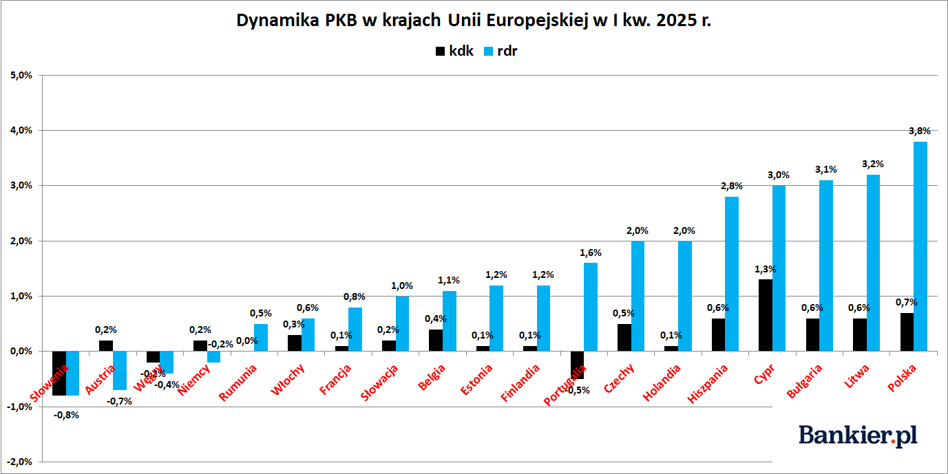EuroPKB: Poland is the champion of Q1. Germany still in the relegation zone

Apart from the highly questionable statistics from Ireland, Poland in the first In the first quarter of 2025, it recorded the highest annual gross product dynamics among the countries European Union. Germany may have avoided a formal recession, but its GDP is still was lower than a year earlier.
In the first quarter of 2025, the gross domestic product of the European Union The European Union counted as one economy, however, increased by 0.3% compared to the previous year quarter and was only 1.4% higher than a year ago – it was reported in Thursday Eurostat. Quarterly euroGDP dynamics was slightly lower than the quarter ago, and the growth annual remained at the same level as in the fourth quarter of 2024.
Despite everything, these results are definitely better than what we saw in 2022-23 when Europe was stagnating economic situation combined with very high inflation. From the beginning of 2024, the data However, we can see a slight recovery in GDP, with quarterly dynamics regularly of 0.3-0.4%.
Poland is the economic champion of EuropeThe data released today was the first "regular" gross domestic product estimate for the first quarter of 2025. Preliminary We saw the data at the end of April and we did not have the results at that time for most EU countries. Eurostat has now provided results for 21 of the 27 countries The only missing results were for Denmark, Greece, Croatia, Latvia, Luxembourg and Malta – mostly small economies.
From what we know, the highest GDP growth was recorded in Ireland, where the economy was supposed to grow by an impressive 10.9%. But since years, it is known that Irish gross domestic product statistics reflect not so much the state of the island economy as tax optimization operations global corporations. Hence, we can safely say that Ireland's results omit.
In this case, Poland comes out on top of the EUroGDP ranking, an annual increase of 3.8%. This is a result in seasonally adjusted terms. In Poland, it has become to report a seasonally unadjusted result of 3.2% . Second place went to Lithuania (3.2%), and Bulgaria (3.1%) completed the podium, ahead of Cyprus (3.0%). A quarter earlier, the "medal zone" looked similar: it won Poland ahead of Lithuania and Spain .


Among the largest economies in Europe, Spain was the leader, with GDP growth of 0.6% QoQ and 2.8% YOY. This is slightly less than in previous quarters, but still an impressive result for stagnant standards "old Europe". The Italian economy, with growth of 0.3% QoQ and 0.6% YOY, remained stagnant. France's GDP grew by a symbolic 0.1% q/q after falling by 0.1% in April quarter, and the annual dynamics was 0.8%.
And that's still better than in Germany. The GDP growth of the largest the economy of the Old Continent amounted to 0.2% quarter on quarter (after a decline of the same amount in the previous quarter) earlier), but the annual dynamics remained unchanged at -0.2%. The largest Europe's economy has been in a structural crisis for several years economic and forecasts there is no indication that this will change in the near future .
Only Hungary (-0.4%) and Austria performed worse. (-0.7%) and Slovenia (-0.8%). In turn, the decline in GDP compared to the previous quarter Eurostat recorded only in Hungary (by 0.2% qoq) and Portugal (-0.5% qoq) and in Slovenia (-0.8% qoq). As a result, no EU country experienced a so-called technical recession, i.e. at least two consecutive quarters of GDP decline.

bankier.pl






